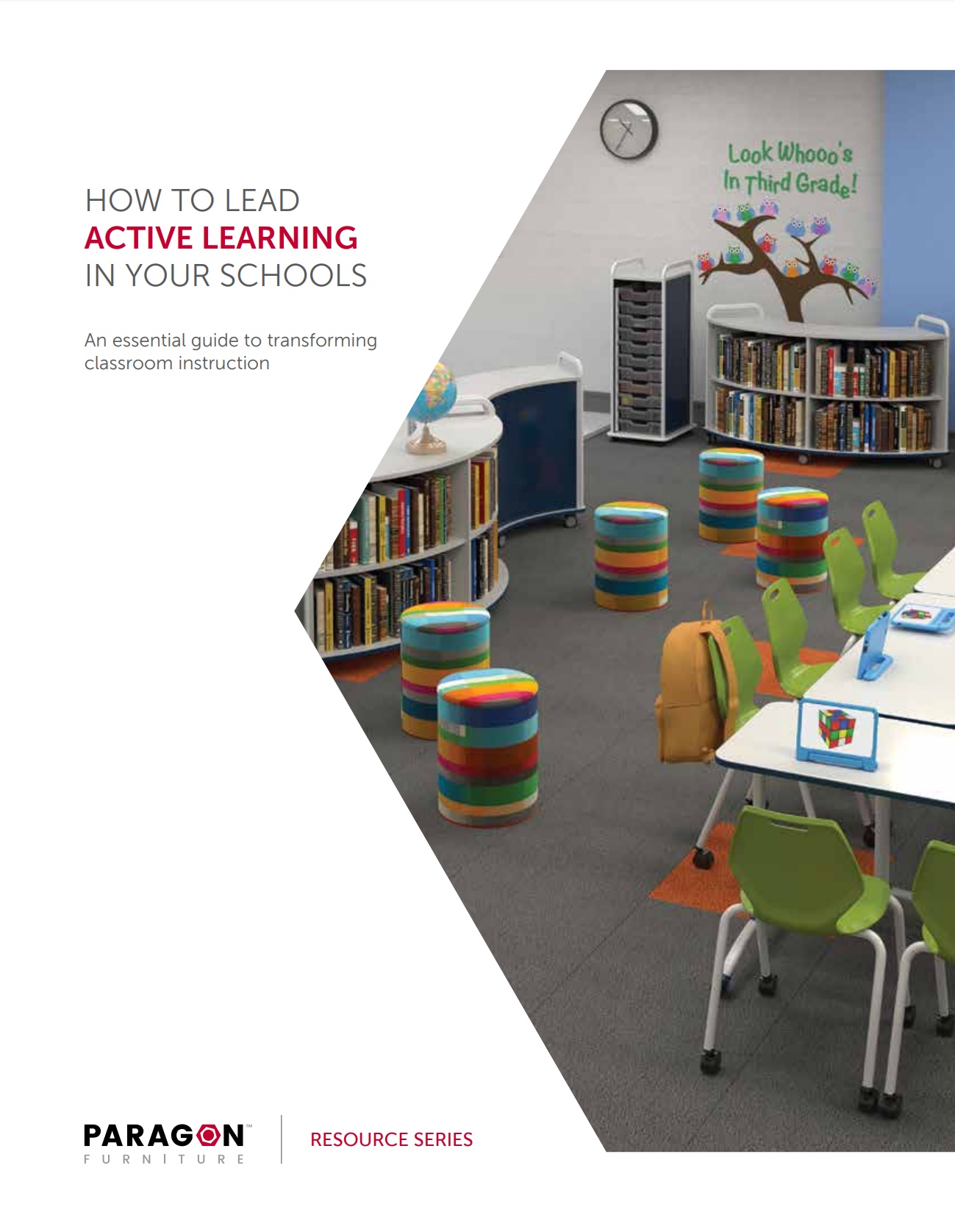SENSORY EXPERIENCES AFFECT STUDENT SUCCESS
SENSORY ERGONOMICS PLAYS A MUCH BIGGER ROLE IN THE CLASSROOM THAN MOST PEOPLE THINK
When we hear that a piece of furniture is ergonomically designed, we typically think of physical comfort. Does the design of the desk or chair “fit” the person for whom it’s intended? Is it comfortable to sit and learn?
is critical—and this can have a big impact on student achievement.

Factors such as color and texture can affect a student’s mood significantly, and decades of research suggests this can influence a student’s ability to focus or succeed—for better or for worse.
In a 2003 paper titled “The Impact of Color on Learning,” Kathie Engelbrecht, then an interior designer for the architectural firm Perkins & Will of Chicago, wrote, “Just as we are programmed to identify with the human face, our body has a basic interpretation and reaction to certain colors.”
“JUST AS WE ARE PROGRAMMED TO IDENTIFY WITH THE HUMAN FACE, OUR BODY HAS A BASIC INTERPRETATION AND REACTION TO CERTAIN COLORS.”
Bright primary or neon colors will generate excitement, increase awareness of one’s surroundings, and heighten the mind’s production of chemicals that increase energy and activity. Muted colors or monochromatic environments have the opposite effect, triggering the release of chemicals in the brain that promote relaxation, calm, and lethargy.

Engelbrecht cited Frank H. Mahnke’s book Color, Environment and Human Response, in which Mahnke offered guidelines for integrating color into schools based on his own research in the fields of color and environmental psychology. Mahnke’s guidelines suggest that ideal color schemes depend on a student’s age and on the function of the space in question:
- Preschool and elementary students prefer warm, bright colors, while cooler colors are recommended for upper grade and secondary classrooms.
- Hallways can have more color range than classrooms and can be used to give the school a distinctive personality.
- Libraries should use pale or light green colors to enhance quietness and concentration. Rooms, or sections of classrooms, that are intended to promote activity can use brighter tones.
Researchers Kristi S. Gaines and Zane D. Curry from Texas Tech University summarized a number of studies about the effects of color on students’ emotions and academic performance of students in a 2011 paper titled “The Effects of Color on Learning and Behavior.”
“Color is a powerful design element that produces profound psychological and physiological reactions,” they wrote. “Studies have shown a relationship between color preferences, emotions, and academic performance in students.”
“STUDIES HAVE SHOWN A RELATIONSHIP BETWEEN COLOR PREFERENCES, EMOTIONS, AND ACADEMIC PERFORMANCE IN STUDENTS.”
However, because color affects different types of students in different ways, it’s hard to draw any definitive conclusions about which colors are best for which types of learning environments, Gaines and Curry wrote. For instance, “the research conducted by Torice and Logrippo (1989) has shown that active children prefer cool colors and passive children are more comfortable surrounded by warm colors.”
To support a classroom environment that is as inclusive as possible, Gaines and Curry recommended a healthy “balance” in color applications for classrooms. Walls should be painted in warm, neutral colors, they recommended, while other elements of the room—such as the furniture—might offer a variety of color choices.
“WALLS SHOULD BE PAINTED IN WARM, NEUTRAL COLORS, THEY RECOMMENDED, WHILE OTHER ELEMENTS OF THE ROOM—SUCH AS THE FURNITURE—MIGHT OFFER A VARIETY OF COLOR CHOICES.”
Discovering a child’s color preferences and using those colors may be beneficial,” they added.
Students’ moods and emotions are influenced by more than just color. Textures, too, are a factor, says elementary school teacher Erin Klein.
The fabrics and materials that a piece of furniture is made from “also play a big role,” says Klein, who studied interior design in college before becoming a teacher in Bloomfield Hills, Mich. “There are a lot of children coming to school who are diagnosed with autism spectrum disorder or special needs, and a lot of them can be heavily affected by the different textures that are in classrooms.”
Some students take issue with soft fabrics, for instance. “If they have dry skin or eczema, their skin will naturally snag on some of the fabrics,” Klein says. “To us, it might sound silly—but for them, they become hyper-focused on the furniture, and they’re not able to concentrate on anything else. Anyone who’s ever been around a child who has some sort of sensory disorder will immediately relate to this.”
Often, it’s these environmental factors “that really inhibit students from being able to focus,” she concludes—“let alone enjoy the learning space.”
As with color, the key for educators is to offer furniture with a variety of textures—including both hard and soft seating options—because children react to different textures or materials in different ways.

“Just like when we personalize instruction—the more ways we teach, the more students we reach—the more furniture options we have, the more accommodating we will be to our students,” Klein explained.
“JUST LIKE WHEN WE PERSONALIZE INSTRUCTION—THE MORE WAYS WE TEACH, THE MORE STUDENTS WE REACH—THE MORE FURNITURE OPTIONS WE HAVE, THE MORE ACCOMMODATING WE WILL BE TO OUR STUDENTS,”
At Paragon, we offer both hard and soft seating options, as well as a kaleidoscope of color to help you outfit your classrooms and learning spaces as inclusively as possible. Schools can choose from among more than 60 colors for our High-Pressure Laminate (HPL) surfaces, as well as accent colors for desk and table legs and edge surfaces.
To learn more about our wide variety of color and fabric choices, call (800) 451-8546 or visit paragoninc.com.
Download our step-by-step implementation guide to help create active learning spaces!
CLASSROOM DESIGN FILES
Access all of the design resources you need to create a beautiful classroom!
